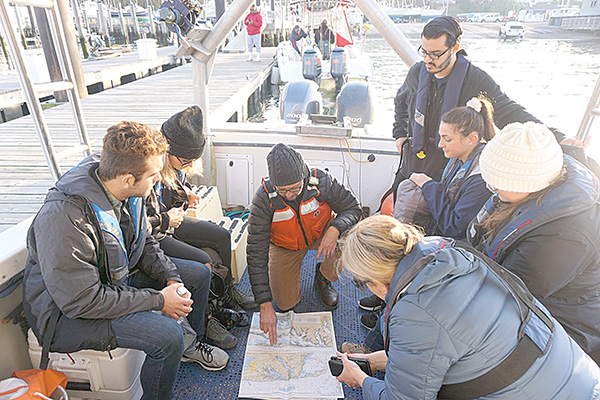
Jason Adolf, a professor at Monmouth University and member of Urban Coast Institute, showed a map to some professors and students while aboard UCI’s R/V Seahawk in Atlantic Highlands.
By Raven Rentas
With data sheets in one hand and a cooler full of chemicals in the other, Faith Teitelbaum spent last summer collecting samples from Whale Pond Brook in Lake Takanassee for Monmouth University’s Urban Coast Institute.
Teitelbaum is passionate about preserving the health of her local lake. She is the director of the Whale Pond Brook Watershed Association and member of the Long Branch Green Team.
The data she and other citizen scientists collect is helping scientists focus on what is causing water quality issues in New Jersey coastal lakes. The research looks at nutrient pollution, stormwater drainage and other factors.
The Coastal Lakes Observing Network (CLONet) was created by the university to understand and improve local lakes. The project focuses on 10 lakes in Monmouth County: Lake Takanassee, Deal Lake, Sunset Lake, Wesley Lake, Fletcher Lake, Sylvan Lake, Silver Lake, Lake Como, Spring Lake and Wreck Pond.
Last summer, students and staff began training community members to collect samples from local waterbodies. Jason Adolf, an endowed associate professor of marine science at Monmouth University and member of Urban Coast Institute, said citizen participation has been a huge success.
“They’ve become a key part of the sampling and data collection to address these water quality issues,” Adolf said. Once participants are trained at a certain lake, they return to the same location every time to collect samples. They collect several lake water quality indicators, like dissolved oxygen and pH levels.
After obtaining samples, participants upload their findings to an online database. Adolf and his students also collect their own samples for the New Jersey Department of Environmental Protection.
“We put the two sets of information together and we’re able to get a much better picture of the lakes,” Adolf said. “We’re able to compare.”
Teitelbaum said one of the most rewarding parts of the project is seeing the community coming together. She volunteers with a group of people who keep each other company as they collect samples. Her group works in pairs, so one does the sampling while one records the data.
“We brought chairs and some food to eat, and basically just helped each other,” Teitelbaum said. “We got to know each other and we got to know the lake.”
While the research is ongoing, they have already found some data regarding the lakes’ conditions. According to Adolf, despite the proximity, the 10 lakes are very different from each other.
“Some lakes have really bad harmful algal blooms that last all summer and others have no trace of them,” Adolf said.
Last summer, harmful algal blooms dominated lakes across the state. The phenomenon is caused by warm temperatures and nutrient pollution, which can come from wastewater, storm drainage and agriculture, among other sources. The researchers have also found that the lakes’ temperatures have increased since 1978. With warmer temperatures and excess nutrients, Adolf believes coastal lakes will suffer the same fate this upcoming summer.
Teitelbaum said she was surprised by some of the data they found. She learned that Lake Takanassee’s dissolved oxygen is out of range, which is why trout fishing isn’t happening there anymore. Now that they know this information, she hopes they can resolve this issue and revitalize trout fishing in the area.
After seeing all the data come together, Teitelbaum became more inspired to improve Lake Takanassee. She said the results led to volunteers from the different lakes talking to each other and sharing their sampling techniques.
Teitelbaum believes CLONet is a great way to make people more aware of their local lakes.
“People are just now beginning to realize what a watershed is and why it’s important,” Teitelbaum said. “They’re asking, ‘What watershed do we live in and how can we help keep it clean?’ ”
Urban Coast Institute’s Artist-In-Residence
Kimberly Callas, an assistant professor at the university and UCI’s artist-in-residence, invites Monmouth County residents to participate in her “Discovering the Ecological Self” project.
“Discovering the Ecological Self” is a social practice project that inspires people to look inward at their intimate connection with nature. Callas came up with the idea after realizing that people are more inclined to live sustainably if they have a reason inspiring them.
“I thought, ‘We have the science but we’re not responding to the science, so how do we get that emotional connection that actually makes us act?’ ” Callas said.
The survey consists of four questions that ask participants to reflect on any symbols from nature that are special to them. It can be accessed at discoverecoself.org. Callas currently hosts “Discovering the Ecological Self” workshops in her class which partners with the nonprofit Aslan Youth Ministry. Each semester they focus on a different theme in nature.
She plans to host public workshops in Monmouth County once COVID-19 is controlled and life resumes. She said the ocean will be the theme over the next two years and the workshops will relate to Urban Coast Institute’s work.
This article originally appeared in the April 9th, 2020 print edition of The Two River Times.














